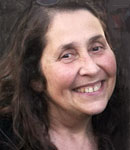
Shelley Sacks
Vita
Shelley Sacks, Prof. Dr., is a social sculpture practitioner working internationally, who has developed creative strategies and theoretical insights on transformation that are integral to both her pedagogic practice and her projects and interventions.
She is passionate about enabling people to ‘come to their senses’ and become ‘agents of change’ that can engage creatively with the challenges of our times. Like her teacher, Joseph Beuys, Shelley’s work is underpinned by the idea that ‘every human being is an artist’ and exploring what this means for shaping a humane and ecologically viable society.
She describes her long-term collaborative projects such as Exchange Values, University of the Trees and Earth Forum as ‘instruments of consciousness’ that link inner work and outer action. Her practice in the field of contemporary social sculpture and connective aesthetics explores the relationship between imagination, transformation and ecological citizenship, and responsibility as an ‘ability-to-respond’. Her work includes more than fifty actions, site works, installations and participatory social sculpture projects; an interdisciplinary connective aesthetics pedagogy and several books and essays.
Shelley writes, lectures, performs and develops projects. She is part of a social sculpture collective scaling up the social sculpture practices through the University of the Trees: Lab for New Knowledge and an Eco-Social Future. She leads a Masters and Doctoral program in Social Sculpture at Oxford Brookes University where she is Professor of Social Sculpture and Interdisciplinary Arts and Director of the Social Sculpture Research Unit.
Born 1950, Bloemfontein, South Africa. Based in Oxford, UK. Shelley studied Fine Art and Aesthetics at the University of Cape Town and was a postgraduate student at the University of Hamburg in 1974/5. She was a student of Joseph Beuys from 1973-75 and collaborated with him for more than a decade in the Free International University. Her work in grassroots cultural and political organizations in South Africa in the 1970s and 80s connected her with the work of Paulo Freire and the field of ‘education for democracy’.
www.social-sculpture.org
www.universityofthetrees.org
Facebook: Social Sculpture Research Unit
Abstract
Das Sakrament der Zukunft ist Begegnung
Was haben Kunst und Kunstpädagogik mit einem Sakrament zu tun? Warum diese religiöse Sprache? Der Begriff ‚Sakrament’ deutet hier auf einen Lernweg hin, der zum Künstler in jedem Menschen führt: der Lernweg im Feld der zeitgenössischen Sozialen Plastik, welches von Schiller, Goethe, Steiner und Beuys, aber auch von u.a. Illich, Freire, Hillman und der Tiefenökologin Macy inspiriert ist. Durch Anwendung phänomenologischer Methoden, in denen ‚bildhaftes Denken’, ‚Wärmearbeit’ und ‚Ästhetik als Gegenteil von Anästhesie’ eine zentrale Rolle spielen, werden auf diesem Lernweg neue Wahrnehmungsorgane gebildet, die eine lebendige Begegnung mit mir selbst, dem Anderen und der Welt ermöglichen. Dieser Vortrag beschreibt einen Freiheitsweg, der aus Bezüglichkeit anstatt Pflicht entsteht. Einer lebendigen Ver-Antwortung, die mit Liebe zur Sache zu tun hat. Angetrieben von innerer Notwendigkeit und mit Hilfe dieser neuen Wahrnehmungsfähigkeiten, erkenne ich was gebraucht wird. Von diesem verbindenden Bewusstsein innerlich mobilisiert, und indem ich als sozialer Künstler innere und äussere Arbeit zusammen führe, arbeite ich jetzt auch mit den ‚unsichtbaren Materialien’, die für die Gestaltung einer humanen und zukunftfähigen Gesellschaft notwendig sind. Das sind die Herausforderungen und der potentielle Beitrag einer erweiterten Kunstpädagogik, welche in ihrem mensch- und weltgestaltenden Potential auch als Sakrament bezeichnet werden könnte.
Fr 11:15 - 12:00
Vortrag




